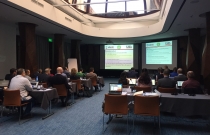PSS/E Automation
The training was designed to improve the capacity of Working Group members to carry out multi-hour grid analyses in PSS/E, which are in line with current ENTSO-E guidelines for Cost Benefit Analysis (CBA) of Grid Development Projects. In addition, Working Group members are provided in advanced automation techniques which can be applied to almost any activity related to usage of PSS/E. PSS/E offers several methods of automation, i.e. mechanisms to control PSS/E execution other than by direct user interaction. These can be used to develop automation files which contain set procedures to be used interactively, or for unattended (batch) operation, where the PSS/E can run a pre-set series of operations to completion with no further interaction from the user. The operations can be fixed, or can be implemented in programming languages to whatever level of complexity is desired. Through this Workshop, the Working Group members were accustomed with properties and scope of application of the following automation processors in PSS/E:
The rest of the workshop was dedicated to Python programming language though following topics:
These topics were covered with 60 practical examples which can also be used as practical reminders. Next session of the Workshop was dedicated to PSS/E Application Programming Interface, development and usage of Python automation files for PSS/E, and it was presented though following topics:
These topics were covered with 9 practical examples which can also be used as practical reminders. The last session of the Workshop was dedicated to Python automation file used for continuous load flow which is in line with current ENTSO-E guidelines for Cost Benefit Analysis (CBA) of Grid Development Projects. Participants were provided with detailed description of all parts of this complex automation file, including input data checking and verification. Participants were also provided with instructions how to customize and extend automation file in order to utilize some specific functionalities. Automation file functionality was explained by using test grid, through 24 continuous study cases, for calculation of line loading and line losses, with following data read from the external data files:
In addition, data consistency check was illustrated by using input files with intentional errors (missing data, inconsistent dates, …). |




